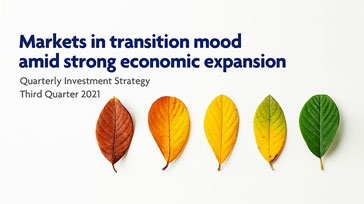Key Points
- Wall Street indices slide in contrast to previous record-breaking weeks
- Investors will be looking at signals from bond yields and earnings reports
- Worries over review of Chinese techs while fund managers favour European markets
The major Wall Street indices declined for the week (12-18 July) following two previous record-breaking weeks – with the S&P 500 down by almost 1% for the week, the Dow by about 0.5% and the tech-heavy Nasdaq losing more than 1.9% after a 4-day losing streak despite lower bond yields which typically favour tech and growth stocks.
Both the S&P 500 and Dow did hit new highs briefly during the week. The S&P 500 is off the record high by 1.6% after Friday’s close. The bellwether 10-year US Treasury yield fell for the third week closing at 1.3% after dipping as low as 1.25% during the week. Other than yields, the unpredictable spread of the Delta Covid-19 variant across the globe prompting renewed social mobility restrictions also weighed on market sentiments.
Then there are also the persistent nagging concerns over inflation despite US Fed chair Jerome Powell testifying to the US Congress during the week that the central bank will remain “accommodative for a while” in what he noted was a “unique” period in US economic history, adding that he expects inflation to stay “elevated” for a while “before moderating” once wage pressures and supply chain kinks wind down.
There were signs that the market was held back during the week by inflation fears, especially after the CPI released on Tuesday showed a 5.4% rise in prices such as homes, vehicles and household durables from a year ago, the fastest annualised increase in nearly 13 years.
Expectations of rising prices weighing down on US consumers were also reflected in consumer sentiments from the University of Michigan at 80.8 for the first half of July, down from 85.5 last month and worse than estimated forecast from economists who projected an increase. A separate survey from the New York Fed also showed consumers believing prices will increase 4.8% in the next year, the highest such reading since August 2008.
Part of the reason for the views of rising prices may be found in the latest monthly US factory output for June which dipped 0.1% due to a drop in vehicle production (down 6.6%) which has been attributed to chips shortage. Such supply bottlenecks including lumber for housing amid strong US pent-up demand have driven up prices in both cars and housing by 30% to 50%.
Overall monthly US retail sales showed a better-than-expected rise of 0.6% for June which points to consumers opening their wallets as the economy reopens which also coincides with the traditional summer travel and vacation season - though that has not lifted Covid-sensitive stocks such as airlines due to an uptick in Delta variant cases in a majority of US states.
There is also a growing perception among investors that peaks in both earnings and economic growth are already priced into stocks. That probably explains the results of the July monthly survey by the Bank of America - showing fund managers becoming “much less bullish” on global growth and corporate profits with the percentage of those who felt the economy would continue to improve falling sharply from 91% in March to 47%.
Seven out of 10 in the poll believed the rise in inflation would be temporary with an equal number expecting the Fed to signal lower monetary policy support via cutback in asset purchases towards the end of the summer with the likely date of the first rate hike pushed to January 2023.
The survey respondents listed inflation and risk of a disorderly market “tantrum” from tapering of central bank support and an economic slowdown in China among the top concerns. Many among the 239 fund managers polled viewed Europe as their most favoured region despite the recent spike in coronavirus cases.
Investors will be looking into data in the week ahead for further signs of inflationary pressures from US housing numbers as well as pace of economic growth in the manufacturing and services PMIs. A slew of earnings reports will come from the likes of Netflix, Twitter, Intel, Honeywell, Coca-Cola; pharmaceuticals like Johnson & Johnson, Biogen and Novartis; United Airlines and American Airlines. The forward guidance from these companies will especially be of interest.
Given the mixed signals from latest data, trading will be likely be rangebound as was the case in the previous reporting season with volumes likely to be lightened by lower retail participation due to summer vacations and more workers heading back to the workplace. The lower volumes may however lead to higher volatility.
Key data out of Asia this week include Taiwan's June export orders (estimated to rise +29.9% on year from +34.5% in May); South Korea's trade data for first 20 days of July and China’s loan prime rate (expected to be unchanged). Investors will be looking for signs of any further fallout from the regulatory scrutiny of Chinese companies over privacy and data concerns.
However, other Chinese techs such as those in areas such as electric vehicles (EVs) which do not maintain huge user data troves will be less affected. The Biden Administration has meanwhile warned American firms of the risks of operating in Hong Kong.
This publication shall not be copied or disseminated, or relied upon by any person for whatever purpose. The information herein is given on a general basis without obligation and is strictly for information only. This publication is not an offer, solicitation, recommendation or advice to buy or sell any investment product, including any collective investment schemes or shares of companies mentioned within. Although every reasonable care has been taken to ensure the accuracy and objectivity of the information contained in this publication, UOB Asset Management Ltd ("UOBAM") and its employees shall not be held liable for any error, inaccuracy and/or omission, howsoever caused, or for any decision or action taken based on views expressed or information in this publication. The information contained in this publication, including any data, projections and underlying assumptions are based upon certain assumptions, management forecasts and analysis of information available and reflects prevailing conditions and our views as of the date of this publication, all of which are subject to change at any time without notice. Please note that the graphs, charts, formulae or other devices set out or referred to in this document cannot, in and of itself, be used to determine and will not assist any person in deciding which investment product to buy or sell, or when to buy or sell an investment product. UOBAM does not warrant the accuracy, adequacy, timeliness or completeness of the information herein for any particular purpose, and expressly disclaims liability for any error, inaccuracy or omission. Any opinion, projection and other forward-looking statement regarding future events or performance of, including but not limited to, countries, markets or companies is not necessarily indicative of, and may differ from actual events or results. Nothing in this publication constitutes accounting, legal, regulatory, tax or other advice. The information herein has no regard to the specific objectives, financial situation and particular needs of any specific person. You may wish to seek advice from a professional or an independent financial adviser about the issues discussed herein or before investing in any investment or insurance product. Should you choose not to seek such advice, you should consider carefully whether the investment or insurance product in question is suitable for you.





